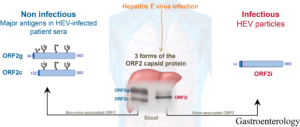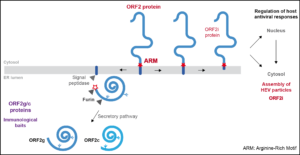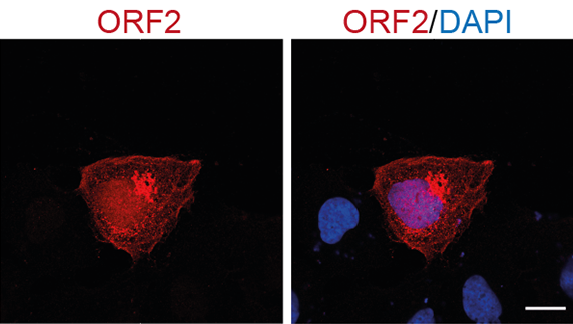HEV genome expresses three open reading frames (ORFs): ORF1, ORF2 and ORF3. ORF1 encodes the ORF1 non-structural polyprotein that is the viral replicase. ORF2 encodes the ORF2 viral capsid protein and ORF3 encodes a small protein that is involved in virion morphogenesis and egress. A fourth protein named ORF4 that is induced by endoplasmic reticulum stress is also produced by some genotype 1 HEV strains.
Due to the size constraint of their extracellular phase, viruses are under strong pressure to minimize their genome size. Gene overlap represents an adaptive strategy developed by many viruses to condense a maximum of information into short nucleotide sequences. This gene overlap strategy is used by HEV for the ORF2 and ORF3 expression and ORF4 in genotype 1. In the study by Hervouet, Ferrié, Ankavay et al., it has been demonstrated that HEV has developed an additional strategy by condensing multiple information into its capsid protein. This strategy is likely also exploited by other pathogens.
Indeed, a few years ago, L. Cocquerel’s laboratory made the pioneering demonstration that, during its lifecycle, HEV produces at least 3 forms of the ORF2 capsid protein: infectious ORF2 (ORF2i), glycosylated ORF2 (ORF2g), and cleaved ORF2 (ORF2c) (Montpellier et al., 2018, Gastroenterology). These ORF2 isoforms perform distinct functions in the HEV lifecycle. The ORF2i protein is the structural component of infectious particles. It is not glycosylated and is likely derived from the assembly of the intracellular ORF2i form present in the cytosolic compartment. Moreover, a fraction of the intracellular ORF2i form is translocated into the nucleus of infected cells. The ORF2g/c proteins are highly glycosylated and secreted in large amounts in culture supernatant and are the most abundant antigens detected in patient sera. These proteins likely act as a humoral immune decoy.

In their recent study, Hervouet, Ferrié, Ankavay et al. deciphered the molecular determinants of ORF2 multifunctionality (Hervouet, Ferrié, Ankavay et al., 2022, PLoS Pathogens). Indeed, by using a series of ORF2 capsid protein mutants expressed in the infectious genotype 3 p6 HEV strain as well as chimeras between ORF2 and the CD4 glycoprotein, they demonstrated how an Arginine-Rich Motif (ARM) located in the ORF2 N-terminal region controls the fate and functions of ORF2 isoforms. They showed that the ARM controls ORF2 nuclear translocation likely to promote regulation of host antiviral responses. This motif also regulates the dual topology and functionality of ORF2 signal peptide, leading to the production of either cytosolic infectious ORF2i or reticular non-infectious glycosylated ORF2 forms. It serves as maturation site of glycosylated ORF2 by furin, and promotes ORF2-host cell membrane interactions. Thus, this study enabled the pioneering demonstration that HEV developed a master strategy to condense multiple information into only five amino acid residues of its capsid protein. The identification of the ORF2 ARM as a unique central regulator of the HEV lifecycle provides insight into how viruses implement strategies to condense their genetic information and hijack cellular processes.

These studies were conducted in the laboratory of Laurence Cocquerel (Univ. Lille/CNRS/Inserm/Pasteur Institute of Lille) and published in Gastroenterology and PLoS Pathogens in 2018 and 2022.
Read the original articles:

